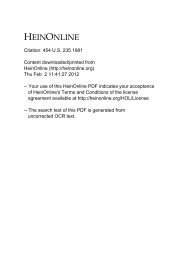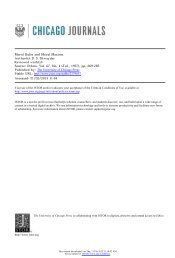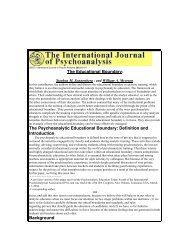A Companion to Linear B - The University of Texas at Austin
A Companion to Linear B - The University of Texas at Austin
A Companion to Linear B - The University of Texas at Austin
You also want an ePaper? Increase the reach of your titles
YUMPU automatically turns print PDFs into web optimized ePapers that Google loves.
§12.1.2.1.5 SCRIBES, SCRIBAL HANDS AND PALAEOGRAPHY 67<br />
Why would <strong>Linear</strong> B scribes, especially their ‘archivists’ and chief recordkeeping<br />
administra<strong>to</strong>rs, <strong>to</strong>ler<strong>at</strong>e the st<strong>at</strong>e <strong>of</strong> writing on Tn 316 when it appears bad<br />
or ‘sloppy’ according <strong>to</strong> modern tastes and standards? <strong>The</strong>re are two reasons.<br />
Reason number one is th<strong>at</strong> the Mycenaeans who wrote records within the<br />
orbit <strong>of</strong> the palaces had the freedom <strong>to</strong> improvise in search <strong>of</strong> a suitable form<strong>at</strong><br />
th<strong>at</strong> they could use efficiently <strong>to</strong> register the <strong>of</strong>ten nearly intractable inform<strong>at</strong>ion<br />
contained in their texts. In longer series, and sometimes, as here, within individual<br />
texts, they used a process <strong>of</strong> trial and error until they got things right.<br />
This aspect <strong>of</strong> the <strong>Linear</strong> B documents is known among Mycenologists as<br />
‘tent<strong>at</strong>iveness <strong>of</strong> formulae or form<strong>at</strong>ting’. 64 Tn 316 deals with very complic<strong>at</strong>ed<br />
inform<strong>at</strong>ion. In some ways it is, syntactically and as a complete record, among<br />
the most complic<strong>at</strong>ed writing assignments <strong>to</strong> come down <strong>to</strong> us from the<br />
Mycenaean pal<strong>at</strong>ial period, or, for th<strong>at</strong> m<strong>at</strong>ter, in all surviving forms <strong>of</strong> Aegean<br />
writing. <strong>The</strong> scribe was hunting for the best way <strong>to</strong> put inform<strong>at</strong>ion down on<br />
this tablet clearly and precisely and using as little tablet space as possible. Also,<br />
once he had started, he understandably did not want <strong>to</strong> waste the work he had<br />
already done, if he did not have <strong>to</strong>.<br />
We see in Fig. 12.18 his experiment<strong>at</strong>ion with ruling and layout, as analyzed<br />
by Bennett. In administr<strong>at</strong>ive record-keeping from clay <strong>to</strong>kens <strong>of</strong> the 4th millennium<br />
BC 65 <strong>to</strong> modern computers, economical and efficient s<strong>to</strong>rage <strong>of</strong> d<strong>at</strong>a<br />
is one high priority. <strong>The</strong> other is not <strong>to</strong> waste time spent working.<br />
To some scholars, this tablet may appear ‘rougher’ and ‘less finished’ than<br />
other documents. Here we have a case where ‘beauty is in the eye <strong>of</strong> the beholder’.<br />
Others, <strong>at</strong>tuned <strong>to</strong> scribal practices, see it as a fine example <strong>of</strong> an ingenious and<br />
effective solution <strong>to</strong> a difficult record-keeping challenge. Our interpret<strong>at</strong>ion<br />
should be guided by palaeographical studies and those who have studied the<br />
work <strong>of</strong> the tablet-writers and know their working conditions.<br />
Palaeographers are thoroughly familiar with the tablets <strong>of</strong> the Mycenaean<br />
scribes. <strong>The</strong>y understand th<strong>at</strong> even very accomplished scribes are uncertain <strong>at</strong><br />
times about how <strong>to</strong> enter inform<strong>at</strong>ion, and th<strong>at</strong> they make corrections or ad hoc<br />
responses <strong>to</strong> the challenge <strong>of</strong> recording inform<strong>at</strong>ion. Simply put, the <strong>Linear</strong> B<br />
clay tablet records, no m<strong>at</strong>ter how important or how elegantly written, are not<br />
fair copies for public viewing nor do they seem <strong>to</strong> have been permanent archival<br />
64 For example (HILLER – PANAGL 2001-2002), in the heading on Pylos tablet Jn 829, the scribe<br />
erases his first <strong>at</strong>tempt <strong>at</strong> listing the <strong>of</strong>ficials involved in the future recycling <strong>of</strong> bronze.<br />
He does this so th<strong>at</strong> he can pair them up on the tablet <strong>at</strong> their appropri<strong>at</strong>e levels <strong>of</strong> power and<br />
responsibility: the ko-re-te-re with the du-ma-te, and the po-ro-ko-re-te-re with the ka-ra-wipo-ro<br />
and the o-pi-su-ko and o-pi-ka-pe-e-we. He also l<strong>at</strong>er adds, as an emend<strong>at</strong>ion, the fact<br />
th<strong>at</strong> the recycled ‘temple bronze’ will be used ‘for spear points’.<br />
65 SCHMANDT-BESSERAT 1992.

















